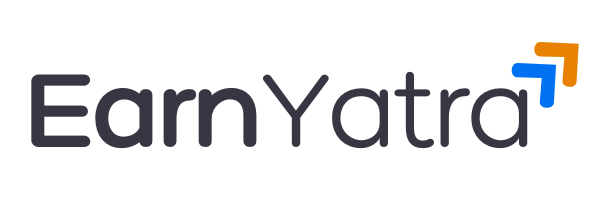Nowadays, the modern business processes cannot operate effectively without document management software (DMS) that has transformed the way organizations manage electronic documents. It permits companies to organize, store, access, and capture files safely, and it also enables teamwork.
Businesses of all kinds in this current digital-first environment generate mountains of documents, whether they are contracts or compliance records. In the absence of DMS, working with such files will be inefficient and dangerous. DMS curbs the data silos, decreases the risk of security issues, and optimizes conformity to regulations.
DMS is very important in applications across industries. It helps in the spheres of healthcare, finance, and law to be compliant with access controls and audit trails. In collaborative work, it allows version control, the management of the workflow, and distribution in a secure manner. It also saves physical storage as well as increasing accessibility.
DMS provides solutions to small companies that want efficient workflow all the way up the chain to big enterprises that need to handle complex compliance. Remote and hybrid workforce applications Relaxed document access on a cloud solution allows employees to have access to documents any time and any place. The upcoming sections will shed light on top 10 document management software and the details associated with them. But, before proceeding let’s discuss the criteria for choosing the ideal document management software.
Criteria for Selecting the Best Document Management Software
The correct decision on the document management software (DMS) depends on whether there are crucial factors affecting the use, performance, and future success.
Ease of Use
An intuitive interface will allow a fast onboarding, accelerate adoption, and reduce disruption. Prioritize intuitive layouts, drag-and-drop functionality, and familiar navigation.
Security and Compliance
DMS must be able to offer powerful encryption, controls, and an audit trail. In the case of regulated industries, aspects such as retention policies and legal holds are indispensable in adjusting to the regulations, such as GDPR or HIPAA.
Collaboration Tools
Superior DMS allows real-time editing, commenting, approval processes, and safe sharing with external users. Version control and notifications streamline teamwork and reduce errors.
Search and Retrieval
Fast, accurate document access boosts productivity. Search full text, metadata filters, and intelligent categorization as a way of retrieval in a short time.
Integration Capabilities
Document management software needs to integrate with CRM software, ERP, email, and productivity. It is cloud-compatible and has all the APIs to easily gain access and customize the integration.
Pricing and Scalability
Assess per-user pricing, storage costs, and feature tiers. Make sure your DMS is scalable in your organization without any drastic reinvestments.
Top 10 Best Document Management Software
1. DocuWare
Website: https://start.docuware.com/
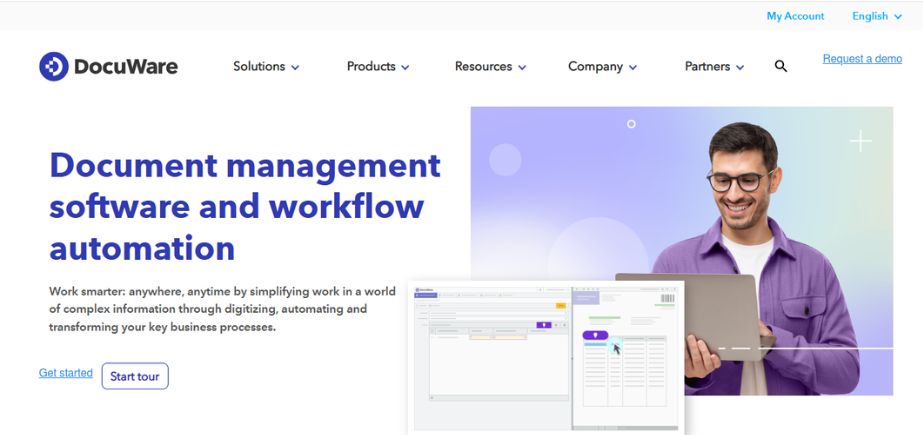
DocuWare is an efficient cloud-based document management software that can automate and organize business operations effectively in mid-sized and large companies. It automates document storage, retrieval, and approvals by use of smart indexing, restricted access, and flexible workflows. DocuWare facilitates remote work and paperless work since it allows working with strong compliance features, electronic signatures, and mobile access. With its full integration with the ERP and CRM systems, it has proven to be an enterprise-friendly entity that can be used at the level of the finance, HR, and administrative departments that seek digital transformation.
Key Features:
- Intelligent document capture and automated indexing
- Workflow automation with customizable approval processes
- Advanced search capabilities with full-text and metadata search
- Mobile apps for document access and approval on-the-go
- Integration with popular business applications like SAP, Salesforce, and Microsoft Office
Pros:
- Highly customizable workflows that adapt to specific business processes
- Strong security features with encryption and access controls
Cons:
- Steeper learning curve compared to simpler solutions
- Higher cost structure may not suit small businesses
Pricing:
Request a demo
Ideal Users:
Mid-size to large enterprises with complex document workflows, regulated industries requiring compliance features, and organizations seeking comprehensive workflow automation alongside document management.
2. M-Files
Website: https://www.m-files.com/

M-Files is unique in its metadata-based document management software, which pays attention to what a document is and not the location where it is stored. This enables users to find documents very fast, irrespective of where they were stored. It facilitates sophisticated workflow, versioning, and compliance, such as audit trails. M-Files has been seamlessly integrated with common applications used in business, such as Microsoft 365, Salesforce, and Teams, which makes it the best product in businesses whose objective is to have intelligent automation, secure collaboration, and scalable information management between and across departments and industries.
Key Features:
- Metadata-driven organization system
- Artificial intelligence for automated classification and tagging
- Version control with check-in/check-out functionality
- Automated workflows and business process management
- Integration with existing systems without data migration
Pros:
- Innovative approach to document organization reduces search time
- Strong AI capabilities for automated document processing
Cons:
- A unique approach may require significant user training
- Higher implementation costs for complex customizations
Pricing:
Book a demo
Ideal Users:
Organizations seeking innovative document organization methods, businesses with complex compliance requirements, and companies looking to integrate DMS with existing systems without major disruptions.
3. SharePoint (Microsoft)
Website: https://www.microsoft.com/en-in/microsoft-365/sharepoint/collaboration
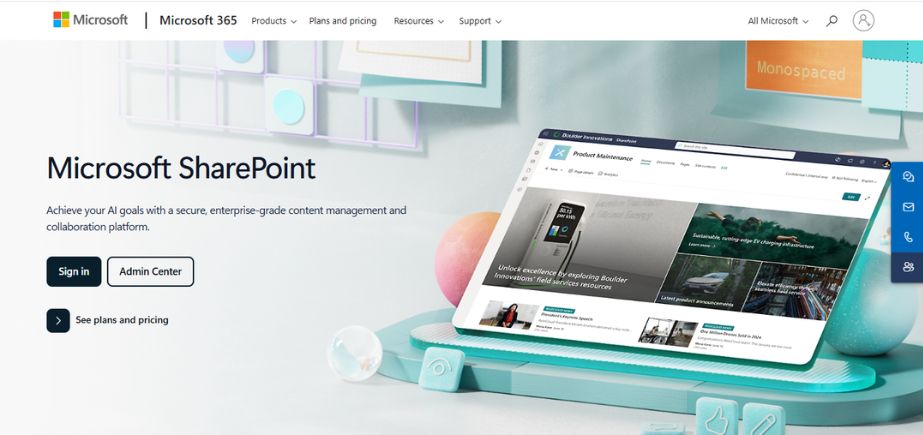
SharePoint is a document management and collaboration platform offered to numerous companies, which is quite similar to Microsoft Office. It makes teams build intranet portals, share documents in an improved workflow, and do so securely. Being closely integrated into Microsoft 365 tools such as Word, Excel, and Teams, SharePoint enables efficiency in work teams and makes content centralized. It has such features as version management, permission management, and co-authoring in real-time, which make it ideal in document-intensive processes, but a certain degree of technical customization can be necessary for full customization and automation.
Key Features:
- Deep integration with Microsoft 365 suite
- Team sites and communication hubs
- Version control and co-authoring capabilities
- Customizable workflows and approval processes
- Enterprise search across all SharePoint content
Pros:
- Seamless integration with Microsoft Office applications
- Familiar interface for Microsoft users
Cons:
- Can become complex with extensive customizations
- Storage limitations may require additional purchases
Pricing:
SharePoint is included with Microsoft 365 business plans starting at ₹145 per user per month.
Ideal Users:
Organizations already using Microsoft 365, businesses seeking integrated collaboration and document management, and companies requiring seamless integration with Microsoft applications.
4. eFileCabinet
Website: https://www.revverdocs.com/

eFileCabinet is an easy-to-use paperless filing solution targeting small to medium enterprises with the requirement to organize their digital documents, quickly retrieve those documents, and automate processes. It has drag-and-drop upload of files, access control through roles, e-signatures, and enforcement tools for finance, human resource industries, and even healthcare. eFileCabinet provides flexibility and high-quality customer support when using cloud and on-premise deployment. Its compatibility with other pieces of software, such as Salesforce and Microsoft Office, ensures high productivity, secure and compliant handling of documents, and ease of operations.
Key Features:
- Bank-level security with encryption and access controls
- Compliance tools for various industry regulations
- Automated workflows and approval processes
- Electronic signature integration
- Optical Character Recognition (OCR) for scanned documents
Pros:
- Strong focus on security and compliance
- Industry-specific templates and workflows
Cons:
- Limited customization options compared to enterprise solutions
- Fewer third-party integrations than competitors
Pricing:
Contact for pricing
Ideal Users:
Professional services firms, regulated industries requiring compliance features, small to medium-sized businesses seeking secure document management, and organizations prioritizing ease of use over extensive customization.
5. PandaDoc
Website: https://www.pandadoc.com/
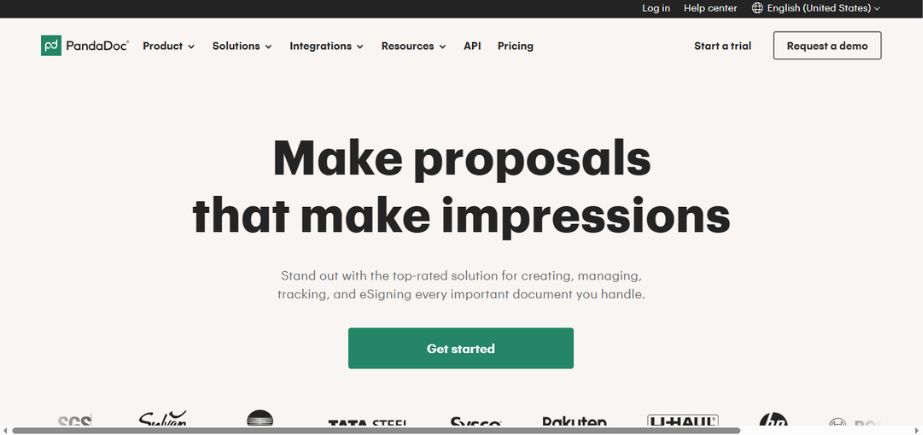
PandaDoc is a software that allows automating documents, eSignatures, and sales, HR, or contract management teams. It is easy to create documents, approvals, and have electronic signing by use of customizable templates, analytics, and workflow tracking. PandaDoc offers functionalities with integration with CRMs such as HubSpot, Salesforce, and Zoho that allow quote-to-close action. Its collaboration capabilities allow work in real-time, and a mobile-friendly interface enhances productivity in distributed groups. PandaDoc is perfect to create proposals, contracts, and onboarding documents, making it easier to manage business agility and document lifecycle.
Key Features:
- Document creation with templates and drag-and-drop builder
- Electronic signature capabilities with legal compliance
- Automated workflows for approvals and notifications
- CRM integration with popular sales platforms
- Analytics and reporting on document performance
Pros:
- Excellent document creation and template management
- Strong electronic signature features with legal validity
Cons:
- Limited traditional document storage capabilities
- Higher pricing for advanced features
Pricing:
PandaDoc pricing starts at $9 per user per month, with business and enterprise plans offering additional features and integration capabilities.
Ideal Users:
Sales teams requiring document automation, businesses with heavy contract management needs, organizations seeking integrated electronic signature solutions, and companies looking to streamline sales document processes.
6. Zoho WorkDrive
Website: https://www.zoho.com/workdrive
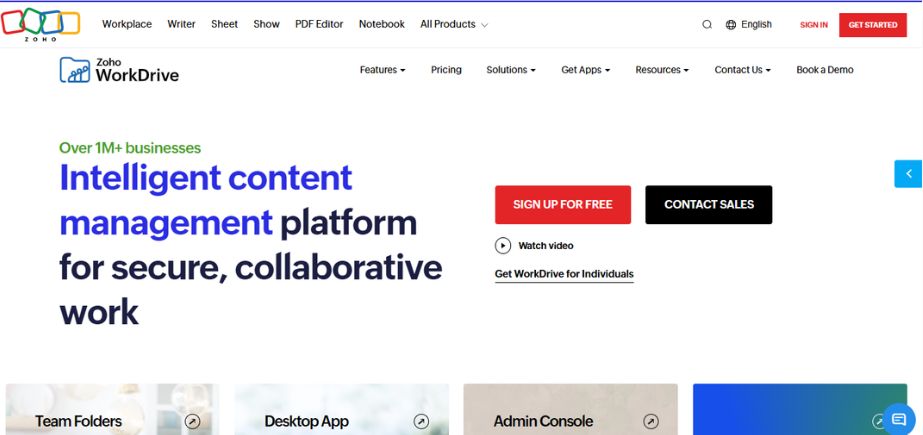
Zoho WorkDrive is a file-sharing and work collaboration system in the cloud with provision of various functions to small to medium-sized teams. It is a part of the Zoho ecosystem, allowing for storing the documents centrally, collaboration in real time, role-specific permission, and offline access to files. WorkDrive provides team folders, administrative control at the granular level, and native integration with other Zoho solutions such as CRM and Projects. It offers secure data processing and a well-organized working environment supporting internal and external collaboration: there are audit trails, file recovery, and encryption.
Key Features:
- Secure cloud storage with encryption
- Real-time collaboration and co-authoring
- Advanced sharing controls and permissions
- Integration with Zoho suite of applications
- Mobile apps for document access and editing
Pros:
- Excellent integration with Zoho ecosystem
- Competitive pricing with generous storage allocation
Cons:
- Limited integrations outside Zoho ecosystem
- Fewer advanced workflow features compared to specialized DMS
Pricing:
Zoho WorkDrive offers plans starting at ₹170/user/month billed monthly (minimum 3 users), making it one of the most cost-effective options available.
Ideal Users:
Organizations using Zoho applications, small to medium-sized businesses seeking affordable document management, teams requiring strong collaboration features, and businesses prioritizing cost-effectiveness over advanced features.
7. Google Workspace (Drive)
Website: https://workspace.google.com/
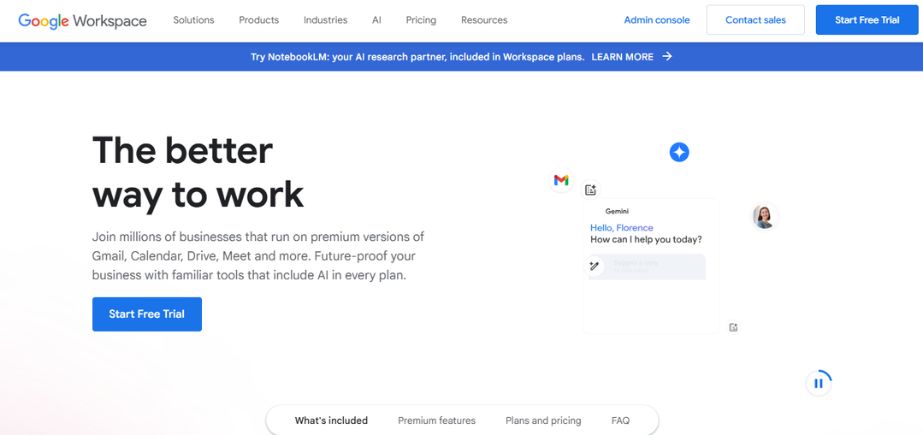
Google Workspace includes Google Drive, which provides cloud-based document storage and sharing and real-time collaboration in Docs, Sheets, and Slides. It is suitable for any size business, as it facilitates remote teams across multiple devices, where files can be accessed without hassle. The AI search and file suggestions are two aspects that make Google productive, and the sharing permissions and version control ensure the data integrity of Google. To enhance the seamless workflow, Google Drive, incorporated with Gmail, Meet, and Calendar, implemented the consolidation of work-related items, but in some sectors, third-party applications are needed to provide sophisticated compliance.
Key Features:
- Integration with Google productivity applications
- Real-time collaboration with simultaneous editing
- Powerful search capabilities across all content
- Mobile apps with offline access
- Advanced sharing and permission controls
Pros:
- Seamless integration with Google applications
- Excellent collaboration features with real-time editing
Cons:
- Limited advanced workflow features
- Privacy concerns for some organizations
Pricing:
Google Workspace plans start at ₹160.65/user/month
Ideal Users:
Organizations using Google applications, businesses prioritizing collaboration and accessibility, educational institutions, and companies seeking cost-effective cloud-based document management.
8. Box
Website: https://www.box.com/en-in/home
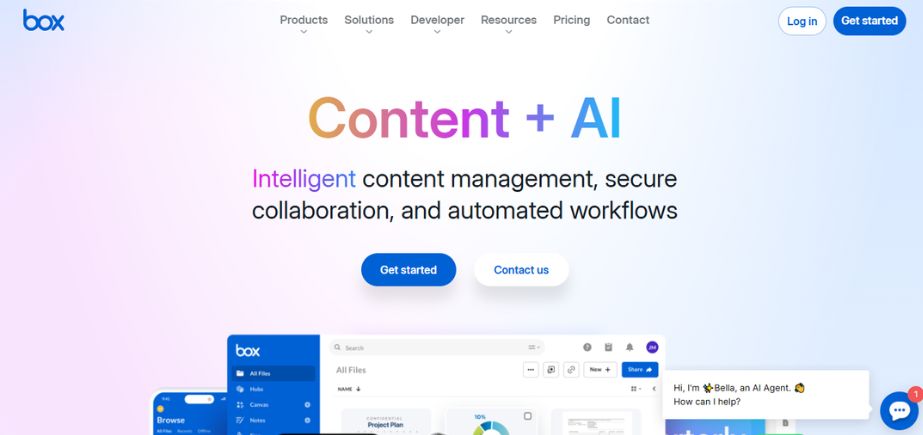
Box is a safe, cloud-based content management and file-sharing system adapted to corporate requirements. It facilitates enhanced access controls, data encryption, e-signatures, and automated workflows. Box is a strong collaborator both internally and between other teams, and has native integrations with Microsoft 365, Google Workspace, Slack, and Salesforce, amongst others. It is suitable in regulated industries because of its AI-driven control and classification tools for the content. Box assists in managing the full content lifecycle within organizations as it ensures compliance and certifications, along with scalable storage.
Key Features:
- Enterprise-grade security with encryption and access controls
- Extensive third-party integrations and APIs
- Advanced sharing and collaboration features
- Workflow automation and approval processes
- Mobile apps with offline access
Pros:
- Strong security features suitable for enterprise environments
- Extensive integration ecosystem with popular business applications
Cons:
- Higher pricing compared to consumer-focused alternatives
- Limited storage on lower-tier plans
Pricing:
Box business plans start at ₹1,160per user/month minimum of 3 users, with enterprise plans offering additional security and compliance features.
Ideal Users:
Large enterprises requiring advanced security features, organizations with extensive integration needs, businesses in regulated industries, and companies seeking comprehensive admin controls.
9. Dropbox Business
Website: https://www.dropbox.com/
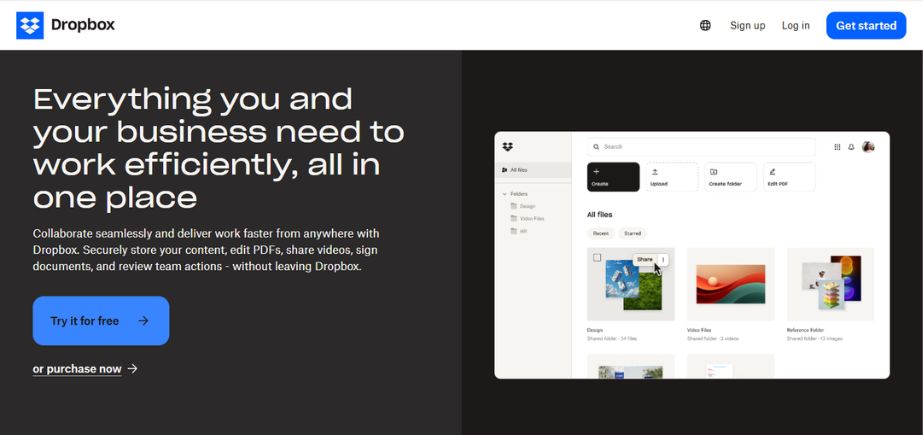
Dropbox Business is a readily used cloud storage and team collaboration tool. It provides a safe location to store files, real-time synchronization, content sharing with elaborate access controls, and file recovery options. Through Microsoft 365, Slack, and Zoom integrations, Dropbox facilitates collaboration processes and cloud-based centralization of content access. Smart Sync, activity tracking, and admin dashboards are features that allow IT teams to keep users and their data organized. Creative and remote teams particularly prefer Dropbox because it is easy to use.
Key Features:
- Familiar Dropbox interface with business enhancements
- Advanced sharing and collaboration features
- Mobile apps with offline access
- Integration with popular business applications
- Admin controls and user management
Pros:
- Familiar interface with minimal learning curve
- Excellent sync performance across devices
Cons:
- Limited advanced workflow features
- Higher pricing for extensive storage requirements
Pricing:
Dropbox Business plans start at $18 per user per month, with advanced and enterprise plans offering additional features and storage.
Ideal Users:
Small to medium-sized businesses seeking familiar document management, teams requiring reliable sync across devices, organizations prioritizing ease of use, and businesses with straightforward document management needs.
10. OpenText Documentum
Website: https://www.opentext.com/products/documentum-content-management
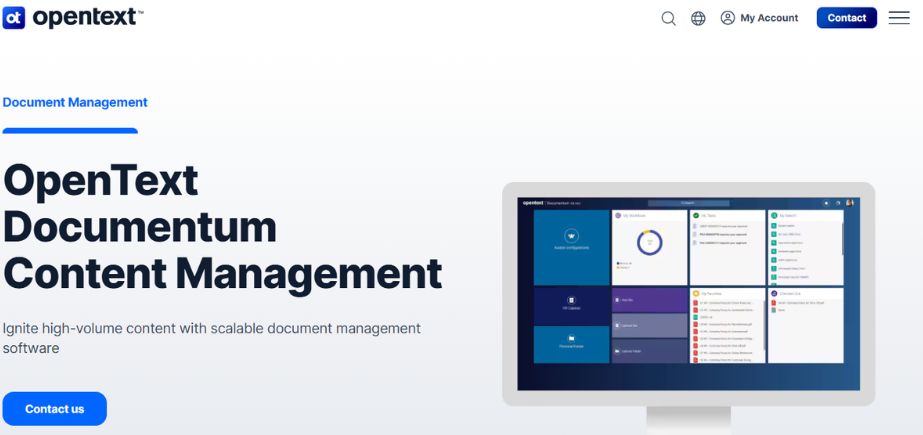
Open Text Documentum is a high-end document management system that is intended for content-intensive and compliance-focused organizations entrusted with healthcare, legal, and government. It offers a central service for document storage, lifecycle, and governance. Documentum allows a lot of customization, provides secure access, an audit trail, and automated workflows. Its scope is increased by integration abilities with enterprise applications such as SAP and Microsoft. It is difficult to set up, but can be very scalable, regulatory compliant, and capable of intense control over the mission-critical content and processes.
Key Features:
- Enterprise content management with advanced governance
- Workflow automation and business process management
- Advanced security features with encryption and access controls
- Compliance tools for various industry regulations
- Integration with enterprise systems and applications
Pros:
- Comprehensive enterprise content management capabilities
- Strong security and compliance features
Cons:
- High implementation and maintenance costs
- Complex setup requiring significant technical expertise
Pricing:
OpenText Documentum pricing is available upon request, with costs varying significantly based on deployment size and specific requirements.
Ideal Users:
Large enterprises with complex content management requirements, organizations in heavily regulated industries, businesses requiring extensive customization and integration capabilities, and companies with dedicated IT resources for implementation and maintenance.
Comparison Table Between Different Document Management Software
| Software | Starting Price | Key Strength | Ideal For | Deployment Options |
| DocuWare | request a demo | Workflow automation | Mid-large enterprises | Cloud, On-premise |
| M-Files | Book a demo | Metadata-driven organization | Complex compliance needs | Cloud, On-premise, Hybrid |
| SharePoint | ₹145/user/month | Microsoft integration | Microsoft 365 users | Cloud, On-premise |
| eFileCabinet | Contact for pricing | Security & compliance | Professional services | Cloud, On-premise |
| PandaDoc | $9/user/month | Document automation | Sales teams | Cloud |
| Zoho WorkDrive | ₹170/user/month | Cost-effectiveness | Zoho ecosystem users | Cloud |
| Google Workspace | ₹160.65/user/month | Collaboration | Google users | Cloud |
| Box | ₹1,160per user/month minimum of 3 users | Enterprise security | Large enterprises | Cloud |
| Dropbox Business | $18/user/month | Ease of use | SMBs | Cloud |
| OpenText Documentum | Custom pricing | Enterprise ECM | Large regulated enterprises | On-premise, Cloud |
Benefits of Using Document Management Software
Time Savings and Increased Productivity
DMS saves time by searching over documents with sophisticated search facilities, auto-filing, and categorizing documents. The employees are able to access files immediately and spend more time on main tasks. It increases the efficiency of the workflow as the time it takes to approve an item and the number of manual errors are minimized.
Improved Document Security and Compliance
The modern DMS systems also provide data encryption, access controls, and an audit trail to protect the data and facilitate compliance. Such attributes as retention policies and safe sharing guarantee compliance with regulations and limit legal threats.
Streamlined Collaboration and Workflows
The teamwork is simplified due to centralized access, real-time editing, and version control. Structured workflows and feedback tools improve review cycles. Cloud access supports remote work and team flexibility.
Reduced Paper and Physical Storage Needs
Office records in digital form reduce printing and storage expenses, besides saving office space. Scalable cloud storage improves security and access. Going paperless supports sustainability and enhances efficiency.
Potential Challenges and How to Overcome Them
Resistance to Change Among Staff
One of the biggest problems when implementing DMS is resistance to change by the staff. Old traditions of working mannerisms can also make employees feel shy about handling new systems. The way to address this is to have personnel involved in choosing the DMS, extensive training, and demonstrating the benefit in pilot projects. Report on progress on a regular basis and report early success stories, in addition to supporting as concerns arise.
Data Migration Difficulties
Migration Data Challenges may hamper implementation because the migration of the already existing documents to a new DMS is usually complicated. It is important to plan carefully by performing data cleaning, standardizing data files, and doing partial rollouts. Write some complicated migrations to be professional, make backups during this migration, and run small test batches first to identify problems early in the process.
Integration with Legacy Systems
The interconnection with legacy systems is also a nightmare, where the older software may not be compatible with the modern DMS. Select a DMS alternative that will have good API or middleware capability to fill the gap. Slowly but surely, upgrades reduce any disturbance, and close coordination with IT departments assists in coming up with strategies that ensure that the work processes run smoothly.
Ongoing Training Needs
Training requirements are also critical since an efficient application of DMS is based on continuous training. Offer one-time training, bi-yearly boosters, and advanced skills as and when new features are introduced. Design internal written instructions and video training based on your processes, and assign power users to help colleagues, and outline the future training requirements.
Conclusion
Selecting the best document management software will play a significant role in ensuring efficiency, security, and a competitive advantage is maintained. The solutions that have been examined in the guide range from free cloud-based tools to solutions that are full enterprise variety, portraying the difference in platforms available to suit the needs of various organizations.
The best way to do it is to realize how and what you need, research the options, and pick a system that would work best with your business objectives and technical capacities. The correct DMS is capable of boosting productivity, lowering expenses, boosting security, and assisting in regulatory compliance activities.
With digital transformation taking off, document management systems will come to the center of business processes. A forward-looking solution that is flexible will enable your organization to keep consistent with the changes in technology, whilst having a good foundation to provide a secure, efficient, and compliant document management process well into the future.
FAQs
What is the difference between DMS and ECM?
DMS documents. ECM works with larger media such as pictures and web files, and it is more developed. DMS is less complicated; ECM is more suitable for various content requirements.
Which is the best on cloud or on-premise document management software?
The DMS cloud is a low-cost solution, scalable, and allows remote access. On-premise is more controlled, and it fits the strict compliance requirements. The combination of both is achieved by the hybrid options.
Is online document storage safe?
Contemporary cloud DMS begins to use encryption and certifications to enhance high-level security. A user and a good setup facilitate protection.
Is it possible to enhance regulatory compliance using DMS?
Yes, but only when coupled with automated retention, audit trail, and access controls, it will be successful as long as it has been configured and people have learned how to use it.
What is the role of DMS in remote working?
Cloud DMS provides anywhere, anytime accessibility and collaboration tools as well as mobile access to maintain a remote workforce that is productive.
